MARIANI’S
Virtual
Gourmet
March 1,
2015
NEWSLETTER

Cary Grant,
Alfred Hitchcock and Grace Kelly during the filming of
"To Catch a Thief" (1955)
IN THIS ISSUE
THE TRATTORIAS OF MILAN
By John Mariani
NEW YORK CORNER
HUNT & FISH CLUB
By John Mariani
NOTES FROM THE WINE CELLAR
WHO NEEDS A TROPHY CELLAR?
By John Mariani
❖❖❖
THE TRATTORIAS OF MILAN
By John Mariani
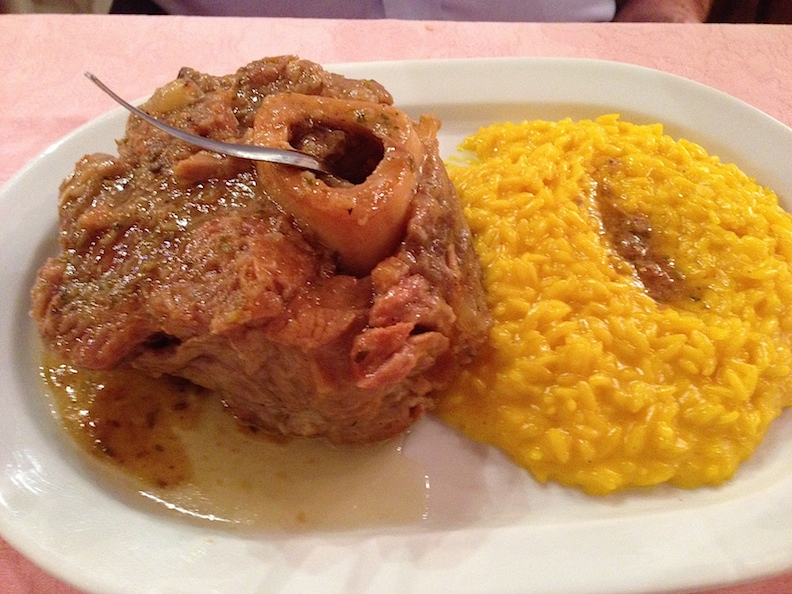
Osso Buco alla
Milanese at Al Matarel
A few
weeks ago I wrote about staying and dining in
some of Milan’s finest
hotels and restaurants, promising I would
report back on the city’s trattorias. So, here
goes.
First of all, since Milan is Italy’s most
important business center--this year hosting the
2015 World Expo--it draws to it all the country’s
regional culinary styles. Thus,
if you wish to eat Tuscan food, there is Bice and Alla
Collina Pistoiesi; for fusion cuisine,
Il Luogo Aimo e Nadia; for Piedmontese, delle Langhe; for
Sicilian, Al
Merluzzo Felice; for Abruzzese, Da
Giannino.
Specialty foods from all those regions are
readily found at the gorgeous--and very
expensive--Gastronomia
Peck food halls (with a nice snack bar
attached).
Milanese (that is, Lombardian)
cooking shares affinities with its neighbors to
the north and east--Switzerland and Austria--so
there is a good deal of butter used. Tomatoes
are less important than in the south of Italy, and
risotto is proudly preferred over pasta. The
cold appetizer vitello tonnato is Lombardian, as
are costoletta
alla Milanese and osso buco--all
featured in profusion in both the city’s high-end
ristoranti and
most humble trattorie.
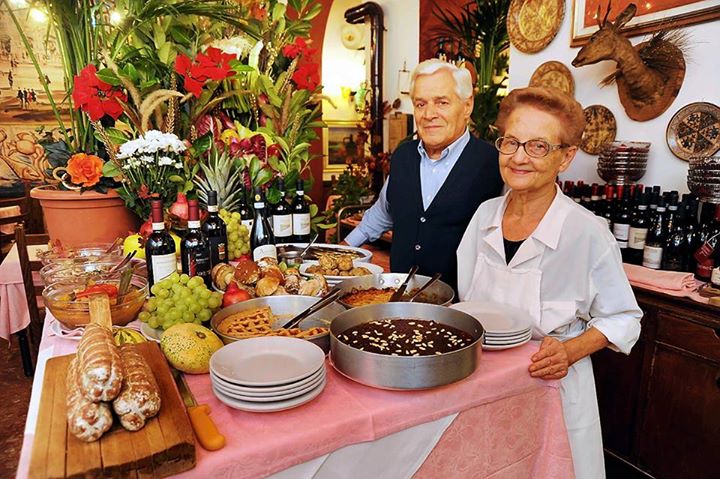 AL MATAREL
AL MATAREL
Via L.S. Mantegazza 2
02-654-204
I will always
admire the longstanding bastion of
Milanese tradition and modernity, Alfredo Gran San Bernardo,
but except
for its grandeur, Savini may be ignored and the
dreary Bouecc
avoided. But among trattorias, I have a new
favorite--al
Matarel, a place recommended by my esteemed
colleague Fred Plotkin, whose Italy for the
Gourmet Traveler (5th
edition) is invaluable. He said the food is terrific but
warned me the owner, Marco, could be grumpy,
especially to out-of-town visitors.
Well, the food was very, very good
indeed. And Marco turned out to be one of the
sweetest, most generous restaurateurs I’ve run
across in the city.
Once you show a sincere interest in food
and wine, you’ve won him over, and you will be
ably assisted by the English-speaking waiter who
interprets.
Al Matarel is just a short walk from the
center city, and, grazie dio!,
one of few places in Milan open on Sunday night. The
interior has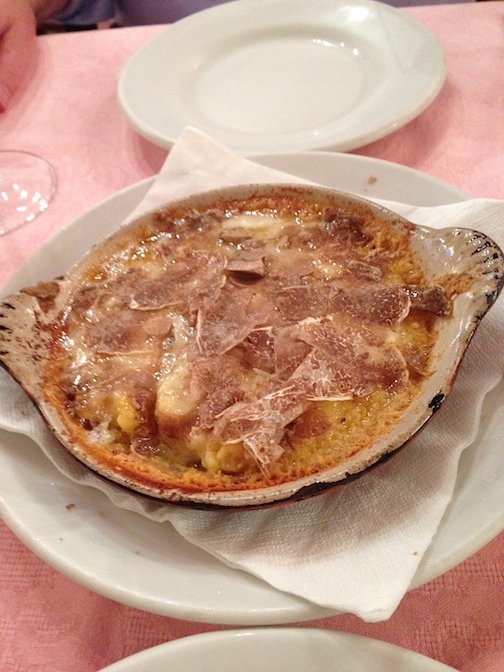 the
typical look of a northern trattoria, brightly
lighted, with red ceiling, pink tablecloths, ferns
and flowers, wine shelves, and sturdy chairs,
though al Matarel is distinguished by a sprawling,
bustling mural of Milan and, for reasons
unexplained, cartoon-like seafood images. The
trim patrician Marco, always in sleeveless sweater
and ascot, takes pride in being 80 years old with
a young wife and chef, Elide, who is 74. They’ve
run al Matarel for five decades, which has allowed
her to perfect every dish, including several you
won’t find anywhere else.
the
typical look of a northern trattoria, brightly
lighted, with red ceiling, pink tablecloths, ferns
and flowers, wine shelves, and sturdy chairs,
though al Matarel is distinguished by a sprawling,
bustling mural of Milan and, for reasons
unexplained, cartoon-like seafood images. The
trim patrician Marco, always in sleeveless sweater
and ascot, takes pride in being 80 years old with
a young wife and chef, Elide, who is 74. They’ve
run al Matarel for five decades, which has allowed
her to perfect every dish, including several you
won’t find anywhere else.
The dialectically
named rustin
n’ga (right)
is a succulent layering of shards if pink veal and
roast potatoes cooked together. She also does a
bubbling, sizzling casserole of Gorgonzola,
potatoes and polenta with white truffles (right), in
season, generously shaved over the top. There’s
Milanese headcheese, tangy and fatty, and her osso buco
with saffron risotto is one of the best of this
prototypical Milanese dish in the city. Marco
suggested three tortelloni on
one plate--with fresh funghi porcini,
pumpkin and spinach with braised beef called stracotto—all
sheathed
inside delicate egg pasta. There
was also a plate of tender ribbons of pasta
glossed with just butter and parmigiano. For
dessert, the dense chocolate cake will bring you
to tears after a meal so satisfying, so honest, so
perfect.
My friend and I were nearly the last people
to leave that Sunday evening, happily regaled by
Marco with his opinions on Milanese food and
Lombardian wines, like the Franciacorta sparkler
we began with and the Oltrepò Pavese we had with
dinner.
I had such
a wonderful evening at Al Matarel, that I doubt
very much I'll ever visit Milan again without
paying homage to Marco and Elide.
Al Matarel is open daily for
dinner. A typical meal will cost about 40 euros,
without wine, but with tax and service included.
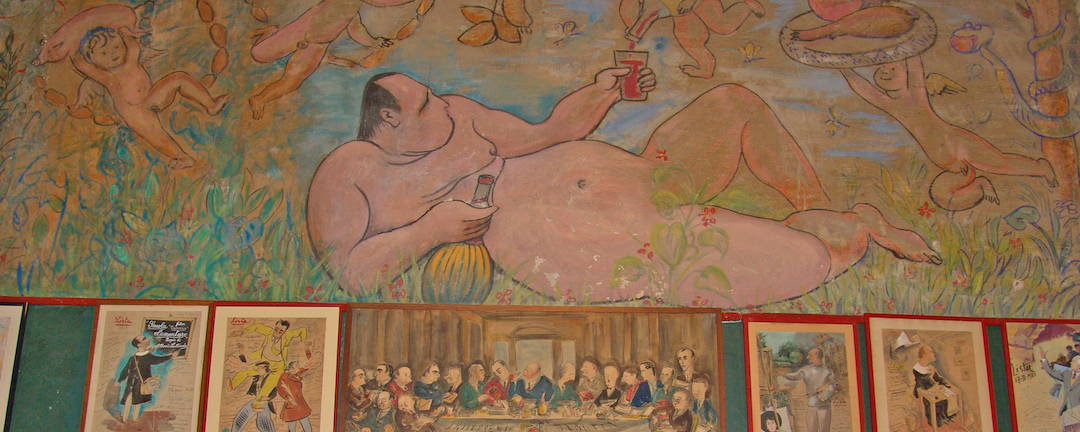 BAGUTTA
BAGUTTA
Via Bagutta, 14
02 7600 2767
bagutta.it
After
a long absence, I returned to Bagutta, a famous
restaurant opened in 1924 by Tuscan Alberto Pepori
(his family still runs it), who early on
cultivated a clientele of journalists and artists,
the latter exchanging paintings and murals for a
meal. After
the war it drew the international movie crowd and
by the mid-1980s, it was, along with Bice, the
favored trattoria among the fashionistas who
worked and shopped on Via Montenapoleone and Via
Bagutta, especially during Milan’s twice-yearly
Fashion Week.
Many a buyer from Bloomingdale’s and Saks
was courted by a fashion designer here, over
plates of tripe alla
fiorentina or beans and black cabbage, still
on the menu today.
Bagutta is still popular,
though I was told the frenetic business people and
fashionistas now rarely have time for a big midday
meal. 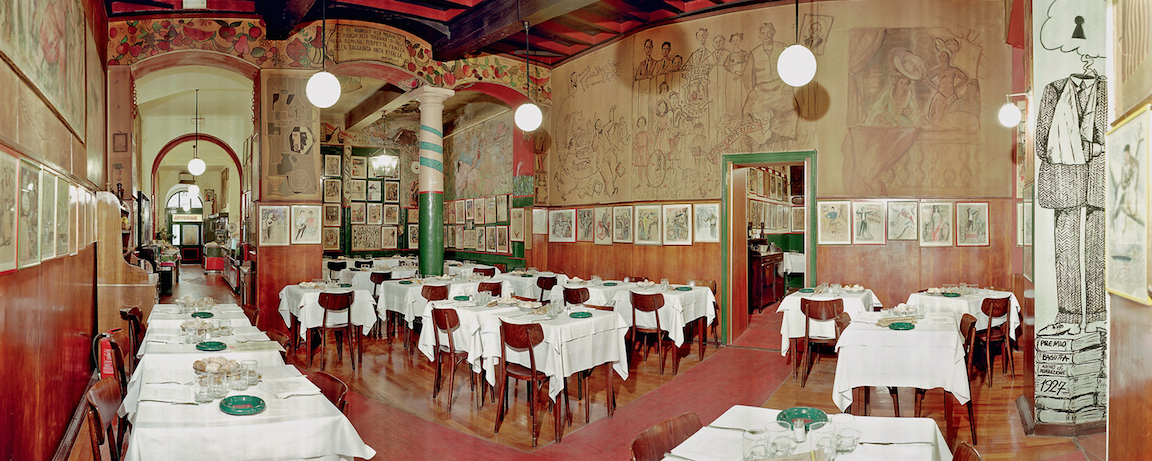 You will
see American and other foreign women toting huge
bags of newly acquired clothes, shoes and
accessories from nearby Armani, Missoni, and
Ferragamo. You
need not dress up to go to Bagutta, but you might
wish to preen a bit.
You will
see American and other foreign women toting huge
bags of newly acquired clothes, shoes and
accessories from nearby Armani, Missoni, and
Ferragamo. You
need not dress up to go to Bagutta, but you might
wish to preen a bit.
The murals remain in
profusion--there was once a di Chirico painting
here but no one seems to know where it is--and
journalists from Corriere della Serra and Il Giorno still
prefer the smaller rooms near the front hall,
while the big open rear room (right) is for
seeing and being seen, not least for watching the
rolling carts of food go by your table, catching
the aromas of white truffles and wishing you
ordered more.
Here the risotto alla Milanese, scented and
colored with saffron, is wonderfully creamy, and
the costoletta
alla Milanese is as crisp and juicy as any
in the city.
The menu changes seasonally,
even daily, but the array of dishes stays well
within tradition, and the wine list has some very
good buys on very good wines, including old stocks
of Tuscan bottlings.
Bagutta has not only very good
food but a strong history to savor as well.
Don't miss being a part of it.
Open Mon.-Sat. A
typical meal will run about 45 euros, without wine, but with tax and
service included.
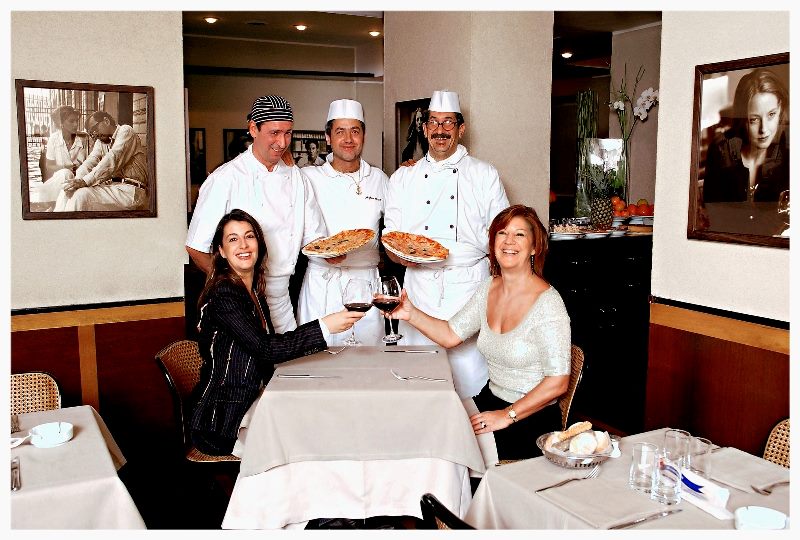 PAPER
MOON
PAPER
MOON
Via Bagutta, 1
02-7602-2297
papermoonmilano.com
Pio Galignani and his
wife, Enrica Del Rosso, were the first to bring
really good pizza to Milan, back in 1977, when
they opened Paper Moon, named after a favorite
American movie of 1973. Pizza in those days
was far from the ubiquitous dish it now is in
Italy--and everywhere else for that matter--and
Paper Moon’s was particularly thin and crisp
crusted, perfect for the models and fashionistas
to snack on after a runway show. The
restaurant’s two-level décor was also quite a bit
more modern than most trattorias in Milan at the
time, decked out in cool white, black and beige,
with reed table mats and wicker chairs, roses
everywhere,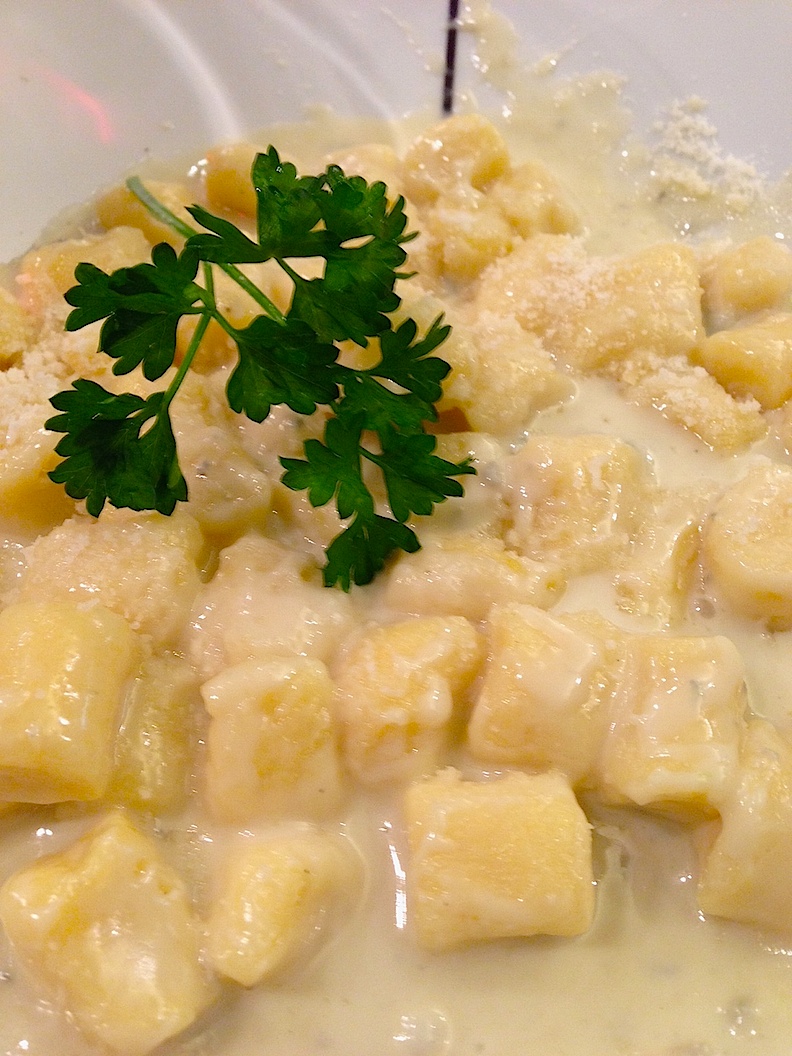 and an
array of movie star photos you’ll recognize. It’s a
style that has traveled well to branches in
Istanbul and Qatar.
(There was a NYC branch once, since
closed.)
and an
array of movie star photos you’ll recognize. It’s a
style that has traveled well to branches in
Istanbul and Qatar.
(There was a NYC branch once, since
closed.)
It’s a well dressed crowd that
jams Paper Moon day and night, though casual chic
is the call. Once you sit down you’ll be treated
to hot strips of olive oil-coated pizza bread
called schiacchiata,
which goes well with the beef carpaccio
or the bresaola. There
are 30 different pizzas available, from one with
Gorgonzola, taleggio and parmigiano to tomato, mozzarella
and artichokes. Lesser pizzaioli have mimicked Paper
Moon’s pizzas by making them thin as crackers, but
the original has just the right heft and chew.
Pastas are also
excellent--one of the best potato gnocchi
lavished with Gorgonzola (right) I’ve ever tasted,
as is the risotto, simply cooked with butter and
parmigiano. They do a fine baby octopus with
polenta, and there’s a slew of grilled daily
specials, from black cod to calf’s liver. For
dessert have the light semifreddo with espresso.
It’s a great deal of fun to
bask in the radiance of Paper Moon. At the
next table is a new Russian model with her agent,
at another a businessman spoiling his son with a
plate of tagliatelle
with white truffles. Over there, some obvious
regulars, but then everyone is greeted effusively
by the Galignani family. Paper Moon is as much fun
as it is a trattoria for terrific food.
Open Mon.-Sat. A
typical meal will run about 45 euros, without wine, but with tax and
service included.
❖❖❖
By John Mariani
HUNT & FISH CLUB
125 West 44th Street (near Avenue of the Americas)
212-575-4949
hfcnyc.com
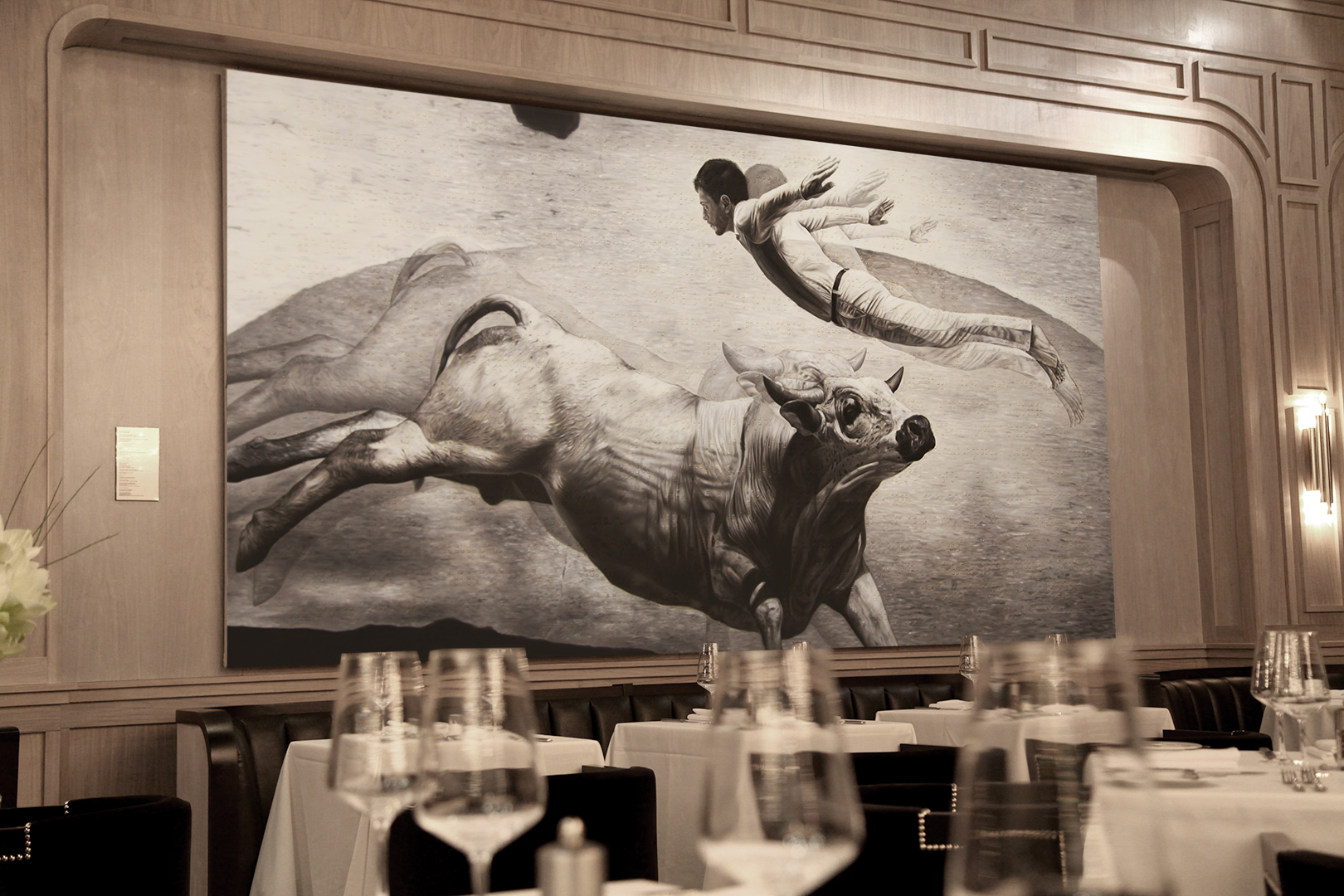 The
hoary axiom about the three most important
things for success in business--location,
location, location--does not seem to apply to
NYC steakhouses, for from the number of
packed dining rooms it’s clear you can
stick one anywhere--uptown, downtown, Lower East
Side, West Village, Tribeca--and it just doesn’t
matter. A new steakhouse in NYC is like the
Statue of Liberty, exhorting fans to “Give
me your tired . . . huddled masses yearning to
breathe free!”
The
hoary axiom about the three most important
things for success in business--location,
location, location--does not seem to apply to
NYC steakhouses, for from the number of
packed dining rooms it’s clear you can
stick one anywhere--uptown, downtown, Lower East
Side, West Village, Tribeca--and it just doesn’t
matter. A new steakhouse in NYC is like the
Statue of Liberty, exhorting fans to “Give
me your tired . . . huddled masses yearning to
breathe free!”
For every night at 6 p.m.,
steakhouses everywhere in the city open their
doors and a torrent of tired, huddled masses
yearning to be free of their office cubicles
blasts through, desperate for stress release, a
dirty Martini or two, and an infusion of red meat.
But, if every location seems
low-risk for a steakhouse, midtown Manhattan
is Steakhouse Central, 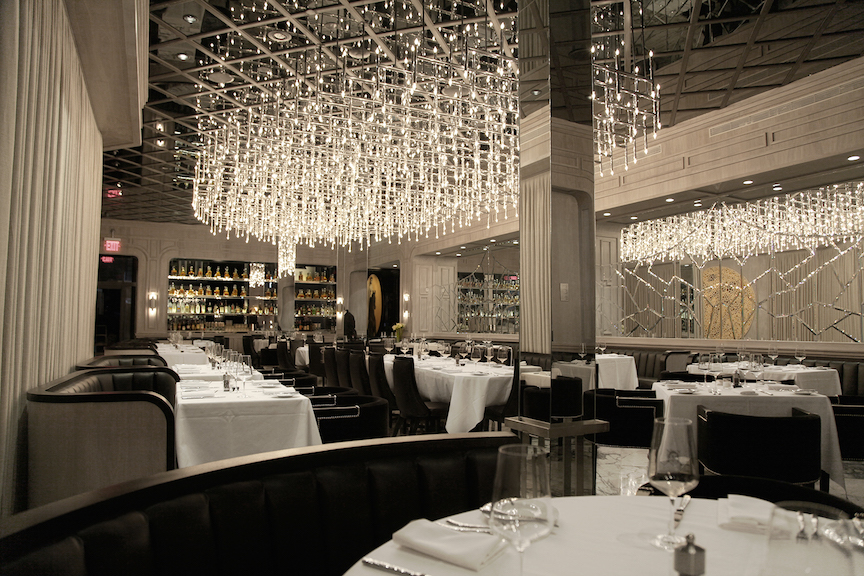 with the old timers like
Palm and Spark’s competing with an unending
barrage of newcomers like Davio’s, Charlie
Palmer’s, NYY Steak, and the brand new Hunt &
Fish Club on West 44th Street. (Strip
House is up the block, Bobby Van’s and Robert’s
one block north, Shula’s one block south.)
with the old timers like
Palm and Spark’s competing with an unending
barrage of newcomers like Davio’s, Charlie
Palmer’s, NYY Steak, and the brand new Hunt &
Fish Club on West 44th Street. (Strip
House is up the block, Bobby Van’s and Robert’s
one block north, Shula’s one block south.)
Like many of the newcomers,
Hunt & Fish Club, which sounds like it should
be set within a logwood lodge hung with moose
heads and fish nets, has gone for a snazzier look
than the traditional yellow walls and dark wainscoting. HFC,
shall we call it, is a steakhouse that aims to
attract as many women as the men who want to buy
them a round of drinks.
HFC sprawls over 9,200 square feet on two
levels, decked out with 55,000 pounds of marble,
180 seats and dramatic, manly artwork by Roy
Nachum and Studio Iyor. The rumored tab was $5
million, which seems low when you look around the
place. “Our goal is to bring back the
character and depth of old school New York in a
contemporary setting,” says co-founder Eytan
Sugarman, “a space that Sinatra would have been
spotted at.”
Ironically, the flashiness of HFC’s décor
was never Old Blue Eyes’ style, for he preferred
quiet, intimate Old World Italian haunts like
Patsy’s on West 54th Street.
The lounge area at HFC is called the “Black
Room,” its backlighted whiskies in crystal
decanters; the main dining area is the “White
Room” (above,
right) with an 40’-by-20’ reflective
chrome light installation; the oasis-themed “Green
Room” has an arched skylight, a self-watering
“living green wall,” and sculptures inspired by—I
kid you not—“the scriptural golden calf,” which,
you may recall, Moses smashed to pieces. Then
there’s the downstairs Blue Room (left) with a
glass-enclosed infinity wine cellar done up with
Roman Reliefs beneath a mirrored ceiling.
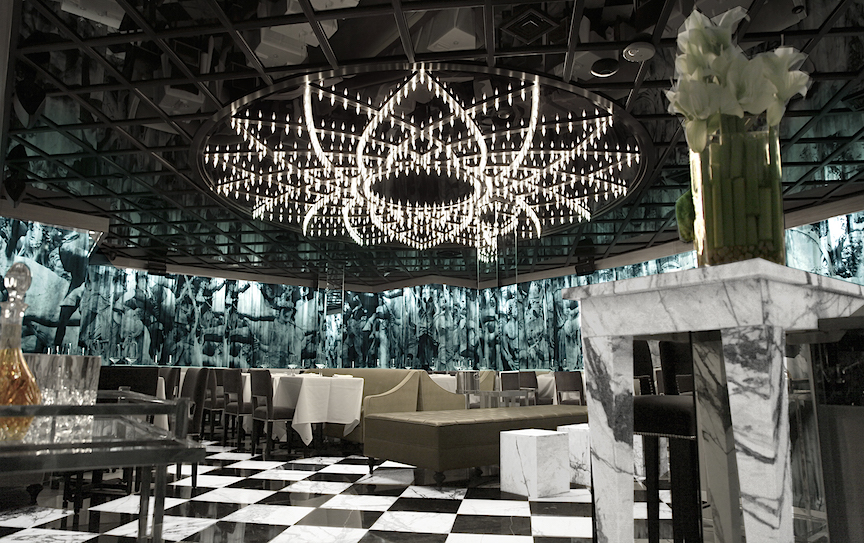 That’s
a lot of
décor, most of it more fit for Vegas than Gotham,
but it’s working well, with a raucous bar crowd
split between two-day-bearded guys in those skinny
suits and their female prey; by six o'clock the
dining room is packed with loud, guffawing men
just out the door of investment banks and bond
agencies, their neckties stuffed into the pockets
of jackets draped over the backs of very
comfortable chairs.
Not surprisingly, after nine o’clock a
gaggle of recently coiffed, very high-heeled,
long-nailed women begin to occupy the most visible
“A” dining room tables, where they sip a flute of
mid-range Champagne and try to guess which men are
most likely senior VPs. As investment entrepreneur
Anthony “The Mooch” Scaramucci (Mr. Sugarman’s
partner) told the NY Post, “This is not for the people
who are taking their kids for a $10 hamburger.
It’s not where the Griswolds would stop.”
That’s
a lot of
décor, most of it more fit for Vegas than Gotham,
but it’s working well, with a raucous bar crowd
split between two-day-bearded guys in those skinny
suits and their female prey; by six o'clock the
dining room is packed with loud, guffawing men
just out the door of investment banks and bond
agencies, their neckties stuffed into the pockets
of jackets draped over the backs of very
comfortable chairs.
Not surprisingly, after nine o’clock a
gaggle of recently coiffed, very high-heeled,
long-nailed women begin to occupy the most visible
“A” dining room tables, where they sip a flute of
mid-range Champagne and try to guess which men are
most likely senior VPs. As investment entrepreneur
Anthony “The Mooch” Scaramucci (Mr. Sugarman’s
partner) told the NY Post, “This is not for the people
who are taking their kids for a $10 hamburger.
It’s not where the Griswolds would stop.”
Sugarman and Scaramucci might easily have
hired a brigade of robotic grill cooks to do
justice to the basic steaks and chops menu, but
instead they hired away Executive Chef Jeff
Kreisel from the illustrious Porter House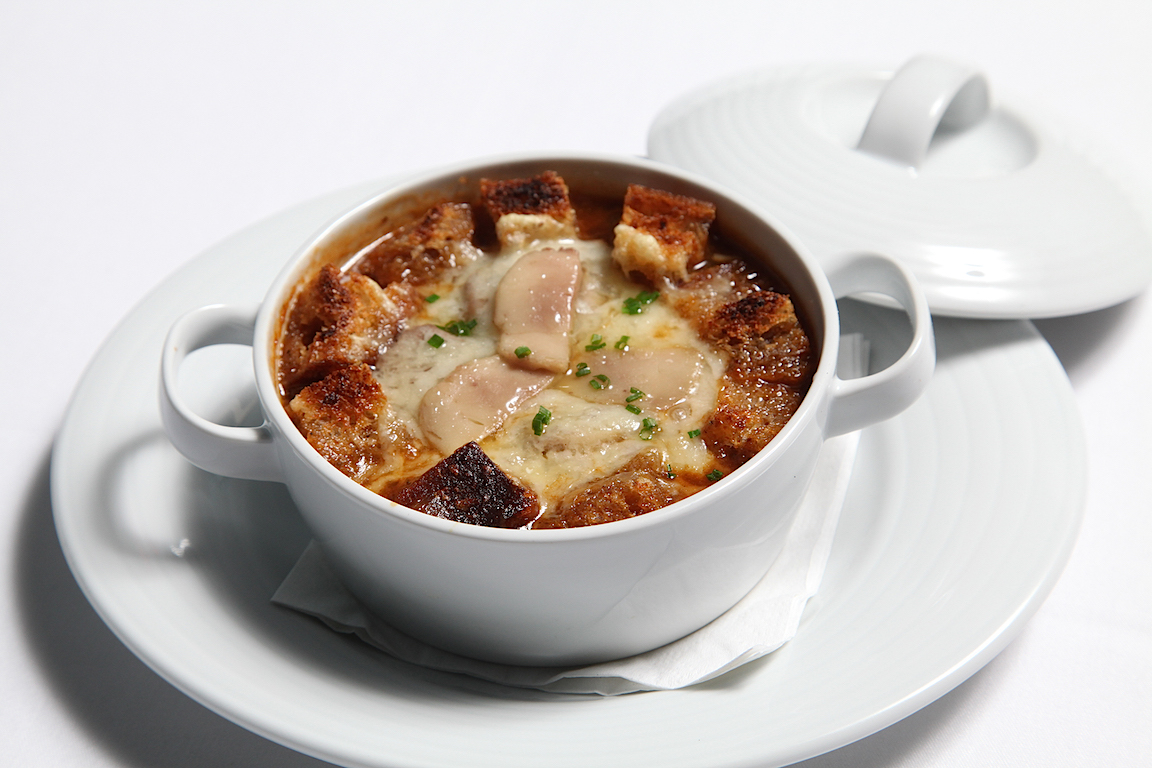 in
Time-Warner Center, as well as one of the city’s
finest pastry chefs, Richard Leach, formerly of Park
Avenue Café. The result is that not only
are the steaks and chops and lobsters impeccably
cooked but other, novel dishes show off the
kitchen’s strength, most saliently one of the best
soups I’ve tasted in NYC--French onion (right) with
morsels of oxtail and bone marrow ($17) that I
could make a meal of. If you go, do not miss this
masterpiece.
in
Time-Warner Center, as well as one of the city’s
finest pastry chefs, Richard Leach, formerly of Park
Avenue Café. The result is that not only
are the steaks and chops and lobsters impeccably
cooked but other, novel dishes show off the
kitchen’s strength, most saliently one of the best
soups I’ve tasted in NYC--French onion (right) with
morsels of oxtail and bone marrow ($17) that I
could make a meal of. If you go, do not miss this
masterpiece.
But first come hot popovers the
size of a softball, laced with Gruyère cheese and
accompanied by good butter at the right
temperature.
The tuna tartare ($19) gains interest from
caramelized pineapple, avocado mousse and crisp
potato. A
jumbo crabmeat cake ($22) lives up to its billing,
and the oysters ($4 each), only two species listed
on the menu, are excellent.
There are 2 ½ pound whole
lobsters ($50), steamed or broiled, and they are
meaty and overflow the plate. If you
don’t go with steak, the grilled Berkshire pork
chop ($29) is a great choice, truly massive in
size at 14 ounces to feed two. There’s no wagyu on
the 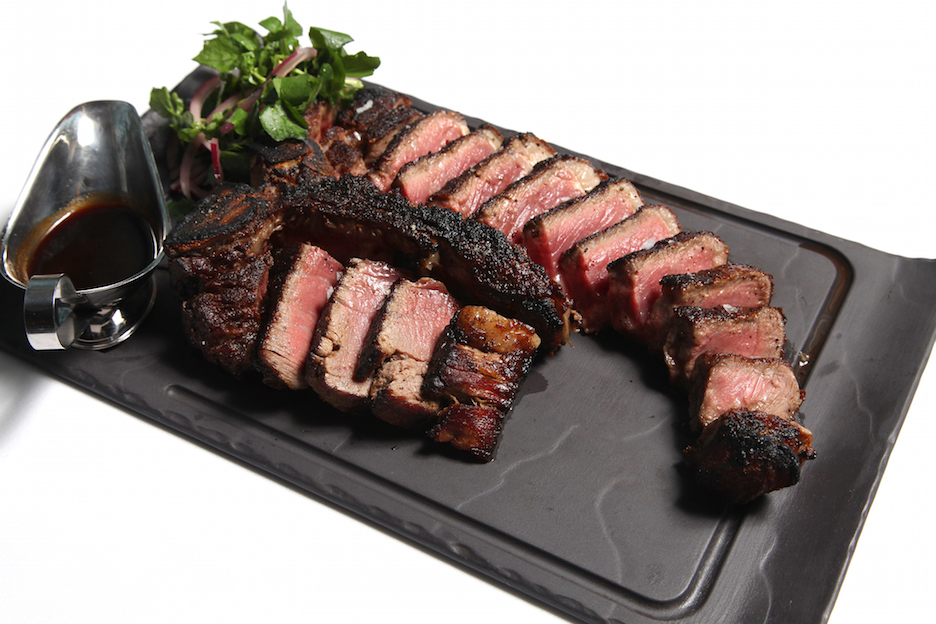 menu--kind
of a relief these days, when everyone claims to
have it--but you’ll be very happy with the
dry-aged porterhouse for two ($55 per person),
which I asked for well charred on the outside and
medium-rare, and it came out perfect.
menu--kind
of a relief these days, when everyone claims to
have it--but you’ll be very happy with the
dry-aged porterhouse for two ($55 per person),
which I asked for well charred on the outside and
medium-rare, and it came out perfect.
Of
the sides I enjoyed, the creamy mashed potatoes
($10) took the prize, and the Brussels sprouts
($12) gained flavor from a bacon vinaigrette; macaroni
and cheese ($11) had more richness than deep
flavor. Skip the too-cute truffle tater tots
($12), which aren’t much of an improvement on what
you had in elementary school.
If HFC is neck and neck with
its steakhouse competition, it soars ahead in the
dessert department, which, with Mr. Leach back
there, is to be expected. Right now he’s doing a
decadent chocolate torte of devil’s food cake,
chocolate ganache and frozen espresso mousse; a
lovely winter spice cake with apple puree and
cinnamon mascarpone; a first-rate crème brûlée
with pecan praline biscotti (right); and
the “everyday sundae,” which can be had
mountain-size at $22; all the other desserts are
$14.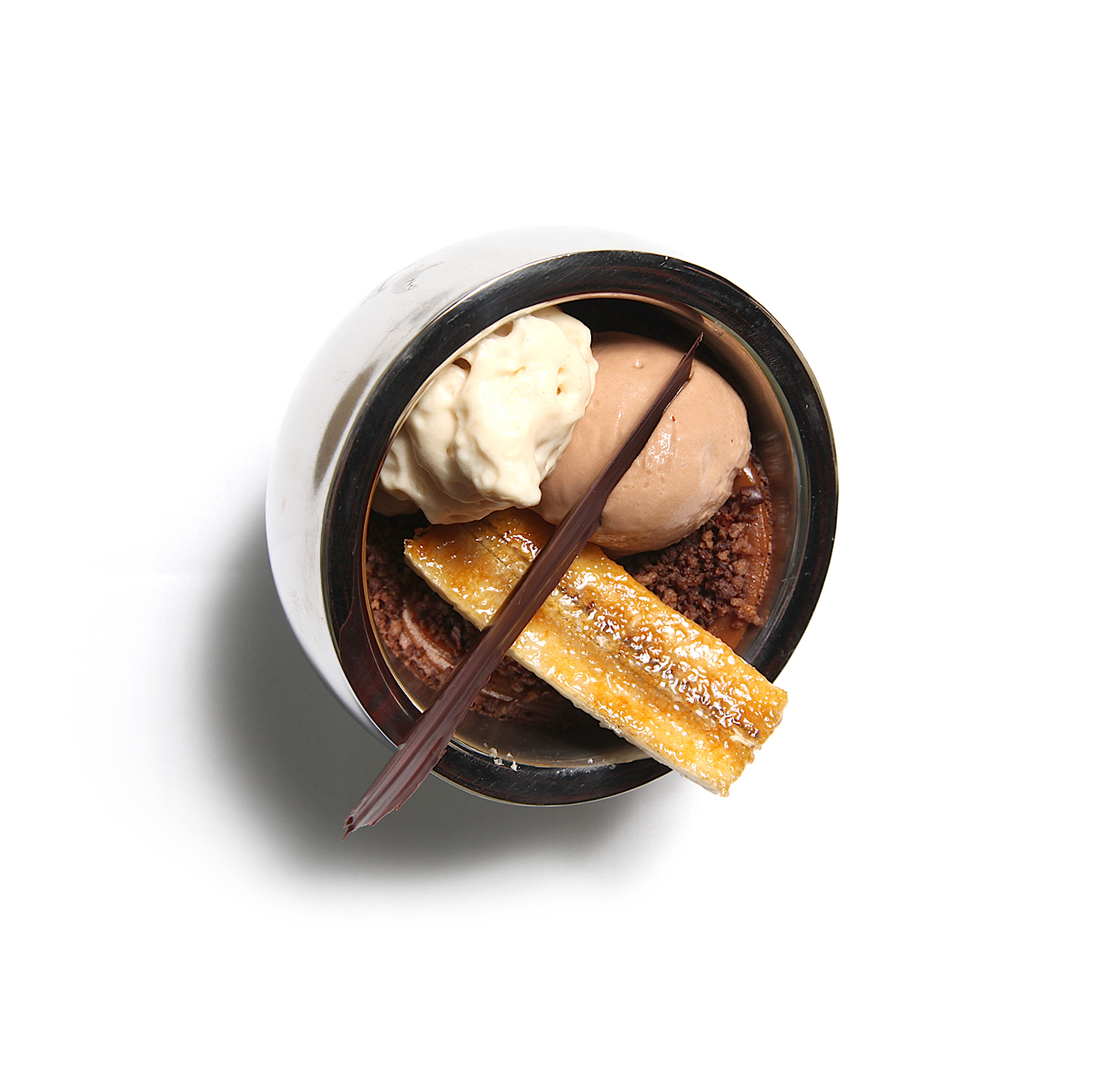
HFC’s wine list is solidly
knit, with a lot of high-end bottles among a
discrete selection under $50. The wineglasses are
not the most elegant you’ll find in NYC.
Clearly the owners of HFC are
seeking a glam crowd and one with lavish expense
accounts, and, after only two months in operation,
they seem to have found the clientele they wanted,
both male and female. So, if you can’t feel
Sinatra’s ghost, you may spot some New York sports
figures and minor celebs like Mario Lopez pressing
the flesh.
The place is cooking on all burners.
HFC is open for breakfast and lunch
on weekdays and nightly for dinner. Dinner is a
la carte or there is a Three
Course Prix Fixe dinner at $75, Three Course
Steak Prix Fixe at $85, and Four Course Steak
Prix Fixe at $95
WHO NEEDS A TROPHY CELLAR?
By John Mariani
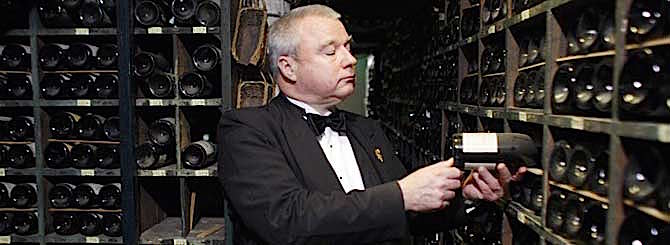
David
Ridgway, sommelier at La Tour d'Argent in Paris
A
recent article in the New York
Times titled “2,300 Wine Choices and Five
Minutes to Select One” poses the question to
several of the city’s top sommeliers as to how a
guest can possibly navigate his way through such
a list with any real discretion. The
sommeliers, of course, explain that that is why
they are employed, to help guests choose a wine
appropriate to their tastes and budget.
The usual examples are given:
the guest should not fear ordering one of the
cheaper wines on the list because the sommelier
vouches for every selection; guests who know
nothing about wine like to show off by pretending
they do; when a restaurant will and will not
remove a bottle from the table, and bill, if it’s
not to the guest’s liking.
What they do not talk
about is why their wine lists are so huge in the
first place. The
Regency Bar & Grill lists 650
selections, Per
Se, 2,300, and at the defunct Cru, 4,500.
Wine
Spectator gives its Grand Award to 68
restaurants with at least 1,500 labels on their
list.
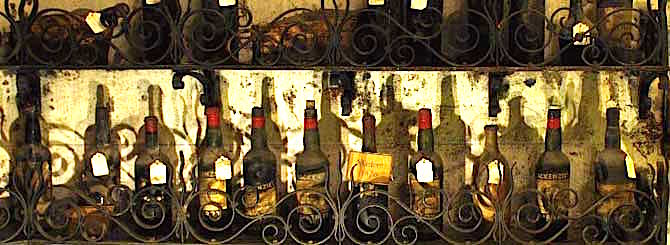 There
are far larger cellars outside of New York—Bern’s Steak House
(below)
in Tampa stores 6,800 and La Tour d’Dargent
(left) in
Paris, stocking its cellar since 400 years ago,
has more than 15,000. The questions is, why?
There
are far larger cellars outside of New York—Bern’s Steak House
(below)
in Tampa stores 6,800 and La Tour d’Dargent
(left) in
Paris, stocking its cellar since 400 years ago,
has more than 15,000. The questions is, why?
Vegas being Vegas, Aureole has
cat-suited "wine angels" swing on wires to
fetch bottles from a four-story, glass-enclosed
wine tower (below,
left) that includes every First Growth
Bordeaux of the year 1900.
Quite obviously, no wine
lover, no matter how wealthy, is going to peruse a
15,000-bottle wine list just to find something
that goes with his dinner. The
time taken just to page through a list the size of
what phone books used to be is time away from the
enjoyment of one’s friends and of the meal itself. Sommeliers
will contend that their lists reflect a desire to
show strength in every category and to please
every taste.
But a list with a mere 200 selections
should pretty much demonstrate those virtues for
99% of the people who order wine.
Such
trophy lists may have 24 Pouilly-Fuissés in
various vintages, so unless the sommelier
regularly tastes them (there’s rarely more than  one or two bottles of
each in the cellar), he has no way of knowing if
they are still in drinkable condition. I’ve seen
lists with vintages I know to be clearly past
their prime on a list, yet there they appear, the
older the more expensive. And,
since the boom years for expense account splurging
ended around 2009, those cellars remain stocked
with scores of oversized bottles of California
chardonnays and Italian cabernets.
one or two bottles of
each in the cellar), he has no way of knowing if
they are still in drinkable condition. I’ve seen
lists with vintages I know to be clearly past
their prime on a list, yet there they appear, the
older the more expensive. And,
since the boom years for expense account splurging
ended around 2009, those cellars remain stocked
with scores of oversized bottles of California
chardonnays and Italian cabernets.
Of course, short of asking for
the 18th Pouilly-Fuissé
down the list--which few if any ever do--you’ll
never know if those wines are even
still in the cellar. “We sold the last bottle
just last night,” is the mantra of sommeliers who
probably haven’t seen a bottle of that label in
months. I
should add that most sommeliers are proud of their
lists and try very hard to winnow out the overaged
and outdated bottlings in their cellars, but by
the same token, few any longer have the budget to
buy anything they like, unless they are positive
they can sell it quickly. The capital investment
in storing a wine like Romanée-Conti, whose recent
vintages may sell in excess of $5,000 a bottle,
for ten years until it matures doesn’t make much
sense anymore.
The real problem with trophy
lists is that they are, even to an indefatigable
connoisseur, intimidating: by offering too many
choices, the guest wades into a quandary that may
appear to be a grown-up’s idea of being a kid in a
candy store but ends the same way--disappointment
that one can’t have everything. It is
not unlike asking a guest at one’s house to
quickly choose which of the 750 recordings of Bob
Dylan songs he’d like downloaded from Spotify for
the next two hours. Or like telling a woman she
has ten minutes to decide which shoes to buy in a
store that stocks 5,000 pairs.
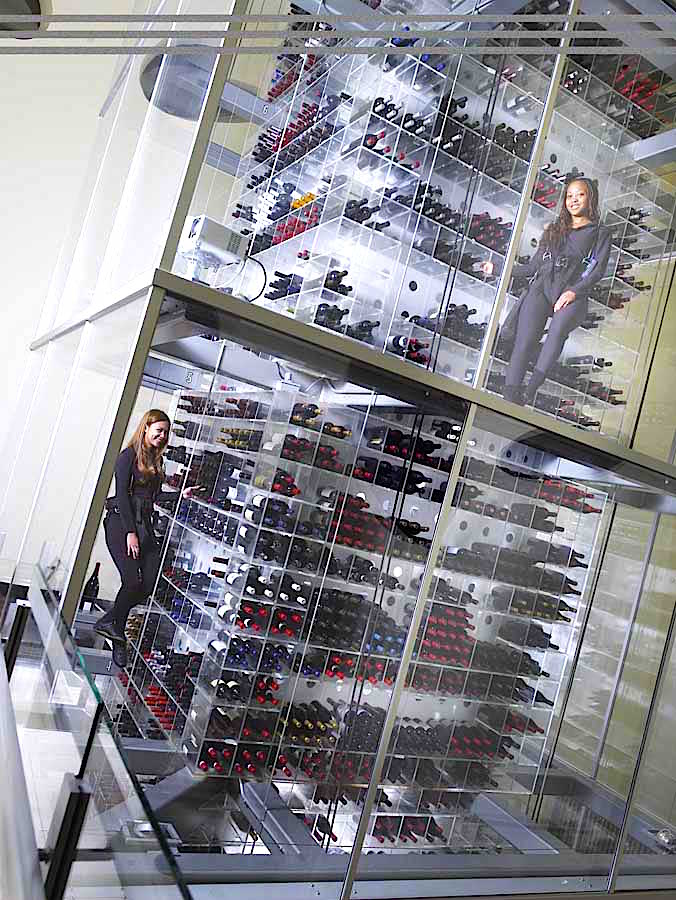 Trophy
lists really exist for two reasons: first, merely
as an
expression of the restaurateur’s ego in the coarse
belief that more must be better; second, trophy
lists lead to the most vulgar displays of rank
money flashing next to buying a mega-yacht. Every
sommelier will tell you of how the most flamboyant
of guests confirm what Oscar Wilde said of a
cynic: “a man who knows the price of everything
and the value of nothing.”
Trophy
lists really exist for two reasons: first, merely
as an
expression of the restaurateur’s ego in the coarse
belief that more must be better; second, trophy
lists lead to the most vulgar displays of rank
money flashing next to buying a mega-yacht. Every
sommelier will tell you of how the most flamboyant
of guests confirm what Oscar Wilde said of a
cynic: “a man who knows the price of everything
and the value of nothing.”
I recall the great
chef-restaurateur of NYC’s Lutèce, André Soltner,
telling of an ostentatious guest with a flashy
date who ordered “whatever’s the most expensive
thing on your list.” When Soltner tried to
dissuade the man from having the only bottle of
1899 Mouton-Rothschild in the cellar, because
Soltner could not vouch for its soundness (and
didn’t want to sell it to such a vulgarian), he
suggested a younger Bordeaux at a lesser but still
extravagant price;
the man said, “Okay, bring that one too.” Both
wines were brought to the table, opened, decanted,
and poured, and, since his date didn’t drink wine
at all, the man guzzled down a glass of each. He
afterwards paid for his dinner in cash, leaving
half the wine in both bottles unconsumed.
Trophy wine lists are useful
only as a promotional aid, like a man who says he
owns five Ferraris he rarely drives and, when he
does, never goes over 75 mph. Wine
Spectator, which gives out thousands of
awards to restaurants with good wine lists, does
not comment on the quality of the food or décor in
such restaurants.
On the other hand, most restaurant critics,
including the Michelin guides,
rarely mention wine lists in their write-ups and
rankings. In
fact, Michelin
insists that the only
thing they pay any attention to is “what’s on the
plate.” Which, of course, most people, especially
restaurateurs, recognize as complete nonsense,
assuming that any restaurant hoping to get three
stars from Bibendum needs to build a trophy wine
list. Michelin insists such things are of no
consequence to their inspectors, which is like
saying that a theater critic pays no attention to
the set decoration or lighting.
There
is a lot of smoke and mirrors in the compilation
of most wine lists.
The best are very focused on pairing the
wines to the chef’s food, 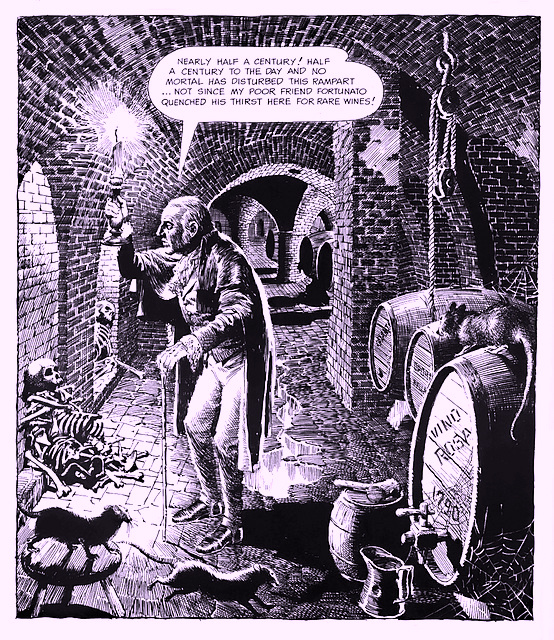 so that a seafood
restaurant with scores of bottles of red wines is
just showing off, even if a few reds might go well
with certain seafood dishes. Why--as
I have experienced in Las Vegas--would a sushi
restaurant stock a dozen vintages of an obscure
Lebanese red wine like Château Musar? Or a
steakhouse have 20 different vintages of German
rieslings? It’s
like offering 60 shades of fuchsia to a man in
charge of painting a high school gymnasium.
so that a seafood
restaurant with scores of bottles of red wines is
just showing off, even if a few reds might go well
with certain seafood dishes. Why--as
I have experienced in Las Vegas--would a sushi
restaurant stock a dozen vintages of an obscure
Lebanese red wine like Château Musar? Or a
steakhouse have 20 different vintages of German
rieslings? It’s
like offering 60 shades of fuchsia to a man in
charge of painting a high school gymnasium.
The worst thing a trophy list
can do is to make a guest feel uncomfortable, and
no matter what a sommelier says, the guest is
always going to feel uneasy ordering the cheapest
bottle on a list whose average prices are $100 and
up.
That is why I applaud those
restaurants where a basic wine list of, say, 100
wines is proffered on a one- or two-page card,
with the option of a larger trophy list, if the
guest should wish to see it. And
those 100 wines on the basic list should be those
the sommelier is excited about at their price
point and which he knows most guests will be happy
with.
And
if a guest wishes to enthrall himself with a
100-page trophy list, at the expense of boring his
guests hungry for food and a little wine, let him
do so at his peril.
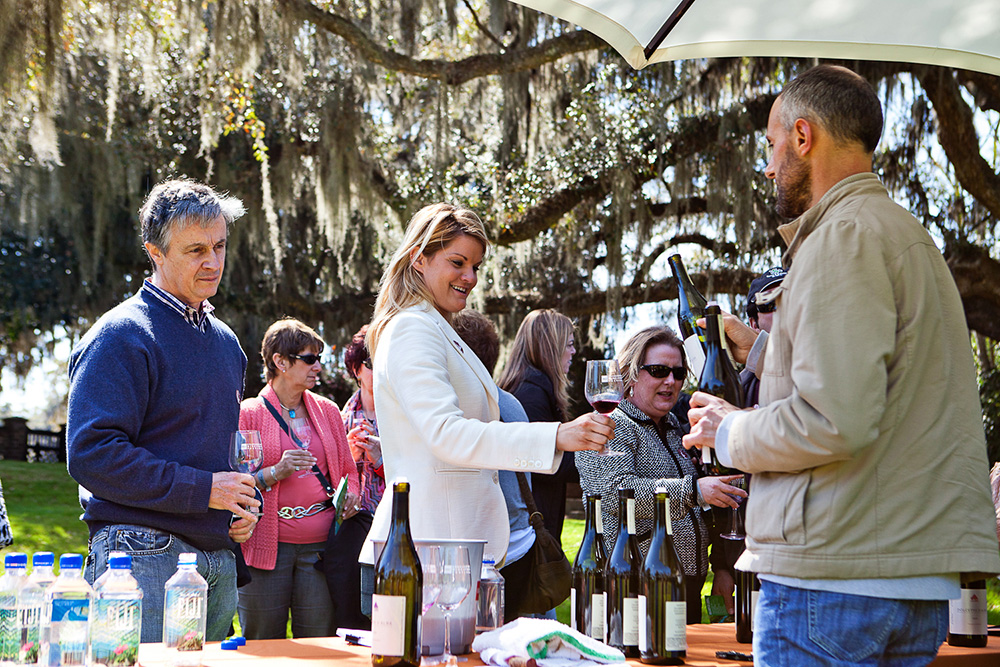
ANNOUNCEMENT
John
Mariani will be attending the 10th
annual BB&T
Charleston Wine + Food from March 4 – 8, a
celebration of the culinary treasures of
Charleston and beyond with over 200 chefs (local
and guest) coming in from around the country to
cook, eat, drink. , With 107 events showcasing the
very best that Charleston has to offer, highlights
incl. Signature Dinners, demos and tastings
at the Culinary Village; Lowcountry
excursions, one-on-one chef and winemaker
interactions, and hands-on
experiences. Call:
843.727.9998 x11.

IT'S
NOT EASY BEING STUPID
Anglo
singer Morrissey refused to perform in Reykjavik because
the show's promoters would not to cater to his
vegetarianism by banning the sale of meat on the
night of his show. "I love Iceland and I have waited a
long time to return," he said,
"but I shall leave the Harpa Concert Hall to their
cannibalistic flesh-eating bloodlust."
RIPPING YARNS OF
RESTAURANT REVIEWING!
“During the five minutes or
so it took to smear this [chilled tartare] on
toasted milk bread and eat it, no force on earth
could have stopped me short of hot lava flowing
under the front door, and even then I would have
made a guess at its speed before deciding to get
up from the counter.”—Pete Welles, “Shuko,” NY Times
(2/15/15)
Any of John Mariani's books below may be ordered from amazon.com.
 I'm proud and happy to announce that my
new book, The Hound
in Heaven (21st Century Lion Books), has just
been published through Amazon and Kindle.
I'm proud and happy to announce that my
new book, The Hound
in Heaven (21st Century Lion Books), has just
been published through Amazon and Kindle. It is a novella, and for anyone who loves dogs, Christmas, romance, inspiration, even the supernatural, I hope you'll find this to be a treasured favorite. The story concerns how, after a New England teacher, his wife and their two daughters adopt a stray puppy found in their barn in northern Maine, their lives seem full of promise. But when tragedy strikes, their wonderful dog Lazarus and the spirit of Christmas are the only things that may bring back his master back from the edge of despair.
WATCH THE VIDEO!
“What a huge surprise turn this story took! I was completely stunned! I truly enjoyed this book and its message.” – Actress Ali MacGraw
“He had me at Page One. The amount of heart, human insight, soul searching, and deft literary strength that John Mariani pours into this airtight novella is vertigo-inducing. Perhaps ‘wow’ would be the best comment.” – James Dalessandro, author of Bohemian Heart and 1906.
“John Mariani’s Hound in Heaven starts with a well-painted portrayal of an American family, along with the requisite dog. A surprise event flips the action of the novel and captures us for a voyage leading to a hopeful and heart-warming message. A page turning, one sitting read, it’s the perfect antidote for the winter and promotion of holiday celebration.” – Ann Pearlman, author of The Christmas Cookie Club and A Gift for my Sister.
“John Mariani’s concise, achingly beautiful novella pulls a literary rabbit out of a hat – a mash-up of the cosmic and the intimate, the tragic and the heart-warming – a Christmas tale for all ages, and all faiths. Read it to your children, read it to yourself… but read it. Early and often. Highly recommended.” – Jay Bonansinga, New York Times bestselling author of Pinkerton’s War, The Sinking of The Eastland, and The Walking Dead: The Road To Woodbury.
“Amazing things happen when you open your heart to an animal. The Hound in Heaven delivers a powerful story of healing that is forged in the spiritual relationship between a man and his best friend. The book brings a message of hope that can enrich our images of family, love, and loss.” – Dr. Barbara Royal, author of The Royal Treatment.
 |
The Encyclopedia of American Food and Drink by John F. Mariani (Bloomsbury USA, $35) Modesty forbids me to praise my own new book, but let me proudly say that it is an extensive revision of the 4th edition that appeared more than a decade ago, before locavores, molecular cuisine, modernist cuisine, the Food Network and so much more, now included. Word origins have been completely updated, as have per capita consumption and production stats. Most important, for the first time since publication in the 1980s, the book includes more than 100 biographies of Americans who have changed the way we cook, eat and drink -- from Fannie Farmer and Julia Child to Robert Mondavi and Thomas Keller. "This book is amazing! It has entries for everything from `abalone' to `zwieback,' plus more than 500 recipes for classic American dishes and drinks."--Devra First, The Boston Globe. "Much needed in any kitchen library."--Bon Appetit. |
"Eating Italian will never be the same after reading John Mariani's entertaining and savory gastronomical history of the cuisine of Italy and how it won over appetites worldwide. . . . This book is such a tasteful narrative that it will literally make you hungry for Italian food and arouse your appetite for gastronomical history."--Don Oldenburg, USA Today. "Italian
restaurants--some good, some glitzy--far
outnumber their French rivals. Many of
these establishments are zestfully described
in How Italian Food Conquered the World, an
entertaining and fact-filled chronicle by
food-and-wine correspondent John F.
Mariani."--Aram Bakshian Jr., Wall Street
Journal.
"Equal parts
history, sociology, gastronomy, and just
plain fun, How Italian Food Conquered the
World tells the captivating and delicious
story of the (let's face it) everybody's
favorite cuisine with clarity, verve and
more than one surprise."--Colman Andrews,
editorial director of The Daily
Meal.com. "A fantastic and fascinating
read, covering everything from the influence
of Venice's spice trade to the impact of
Italian immigrants in America and the
evolution of alta cucina. This book will
serve as a terrific resource to anyone
interested in the real story of Italian
food."--Mary Ann Esposito, host of PBS-TV's
Ciao
Italia. "John Mariani has written the
definitive history of how Italians won their
way into our hearts, minds, and
stomachs. It's a story of pleasure over
pomp and taste over technique."--Danny Meyer,
owner of NYC restaurants Union Square
Cafe, The Modern, and Maialino.
|
 |
 |
 |
 |
 |
 |
 |
 |
 Everett Potter's Travel Report:
Everett Potter's Travel Report: 
 Eating Las Vegas
is the new on-line site for Virtual Gourmet
contributor John A. Curtas., who since 1995
has been commenting on the Las Vegas food
scene and reviewing restaurants for Nevada
Public Radio. He is also the
restaurant critic for KLAS TV, Channel 8 in
Las Vegas, and his past reviews can be
accessed at KNPR.org.
Click on the logo below to go directly to
his site.
Eating Las Vegas
is the new on-line site for Virtual Gourmet
contributor John A. Curtas., who since 1995
has been commenting on the Las Vegas food
scene and reviewing restaurants for Nevada
Public Radio. He is also the
restaurant critic for KLAS TV, Channel 8 in
Las Vegas, and his past reviews can be
accessed at KNPR.org.
Click on the logo below to go directly to
his site.

Tennis Resorts Online: A Critical Guide to the World's Best Tennis Resorts and Tennis Camps, published by ROGER COX, who has spent more than two decades writing about tennis travel, including a 17-year stretch for Tennis magazine. He has also written for Arthur Frommer's Budget Travel, New York Magazine, Travel & Leisure, Esquire, Money, USTA Magazine, Men's Journal, and The Robb Report. He has authored two books-The World's Best Tennis Vacations (Stephen Greene Press/Viking Penguin, 1990) and The Best Places to Stay in the Rockies (Houghton Mifflin, 1992 & 1994), and the Melbourne (Australia) chapter to the Wall Street Journal Business Guide to Cities of the Pacific Rim (Fodor's Travel Guides, 1991).


MARIANI'S VIRTUAL GOURMET
NEWSLETTER is published weekly. Editor/Publisher: John
Mariani.
Editor: Walter Bagley. Contributing Writers: Christopher Mariani,
Robert Mariani, Misha
Mariani,
John A. Curtas, Edward Brivio, Mort Hochstein,
Andrew Chalk, Dotty Griffith and Brian Freedman. Contributing
Photographers: Galina Dargery, Bobby
Pirillo. Technical Advisor: Gerry McLoughlin.
To un-subscribe from this newsletter,click here.
© copyright John Mariani 2015

